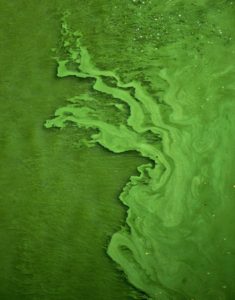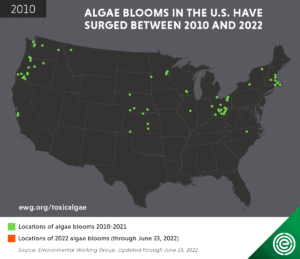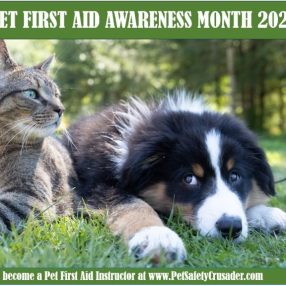
Many dogs love to swim, chase a stick or just splash about in water. It can be a fun sport or great way to cool off however, all water is not created equally. Pools contain chlorine and other chemicals not intended for ingestion, so always bathe your canine’s coat after a dip. Ocean water is salty which may itch your pooch if not rinsed off, and can cause GI distress if consumed, while waters containing algal blooms can be downright deadly to your best friend.
Algae are non-flowering, plant-like organisms that grow in oceans, lakes, rivers, ponds, snow, and other damp environments. They can be tiny, single celled organisms or as large as a kelp forest attached to the sea floor. Algae get most of their energy through photosynthesis, the process by which green plants and other organisms use sunlight to create food. The byproduct of this production is oxygen, and blue-green algae are responsible for making half the oxygen on earth! Nonetheless, blue-algae can be dangerous.
Cyanotoxins
An algal or algae bloom occurs when there is a sudden increase or accumulation of algae in an area. This is usually caused by an influx of nutrients (phosphorus and nitrogen), often from agricultural run-off, warm temperatures, sunlight and still waters. The bloom can often be spotted by the discoloration in the water from the algal pigments. These blooms are a result of blue-green algae, or more correctly — a prehistoric bacteria referred to as cyanobacteria, which tends to thrive in late summer and early fall. “Red Tide” is an example of an algae bloom, but scientists have moved away from using that term since blooms can produce a variety of colors and can be dangerous even when the water isn’t discolored at all.
In 2019, Lake Erie was the location of a toxic algae bloom so large that it could be seen from space! The dominant organism in this bloom was microcystis cyanobacteria which can cause liver damage, dizziness, vomiting and numbness.
While half of cyanobacteria are not harmful to people and pets, there are several species that can produce a number of toxins. These cyanotoxins can result in skin irritation, allergic reactions, vomiting, diarrhea and abdominal pain just from making contact with the bloom. If your dog ingests water containing cyanotoxins, he could suffer damage to the kidneys, liver and central nervous system, resulting in death!

Protecting Fido
Since not all blue-green algae blooms are toxic, how do you protect your pet? For starters, the presence of blooms indicate cyanotoxins may be present, so…
1) Keep an eye out for signs, flags or other methods local health authorities post to inform the public of water quality. Even if signs aren’t visible, look at the water and make sure the color is normal before you let your dog dive in. Blooms coat the surface with a scum ranging in color from brownish-yellows to reds and greens. Since not all blooms rise to the surface, noticing murky or milky water could mean a bloom. If you can’t see your feet or paws, do go in! You can also test the water.
2) Use a swim guide app to determine if the water way you are planning to visit has passed water quality testing.

3) If you can’t immediately bathe your dog after a swim, have the ability to immediately rinse him with fresh water. Know where the nearest animal emergency center is wherever you travel with your pooch, just in case he shows any signs or symptoms, which usually occur 15 minutes to several days after ingestion, and may include:
- Diarrhea/vomiting
- Drooling
- Weakness,
- Disorientation/confusion
- Collapse/unconsciousness
- Seizures
- Breathing difficulties
4) Carry fresh drinking water at all times, so that your dog will be less inclined to sample lake or pond water. Boiling water with cyanobacteria does not reduce its risks. That includes cooking fish caught in a lake contaminated by bacteria – paws off! Additionally, dry algae on the shore gets crispy, and dogs will eat it. The toxic effects kick in rapidly.
Don’t let a fun day at the lake, turn deadly for your best friend. As the planet warms, blooms are occurring more frequently therefore, leading to a greater chance for exposure. Be observant and never let your dog near water that could potentially be dangerous, wash Fido immediately anytime he goes for a swim or even dips paws, and if you suspect he has consumed toxic water, get to your veterinarian immediately!










